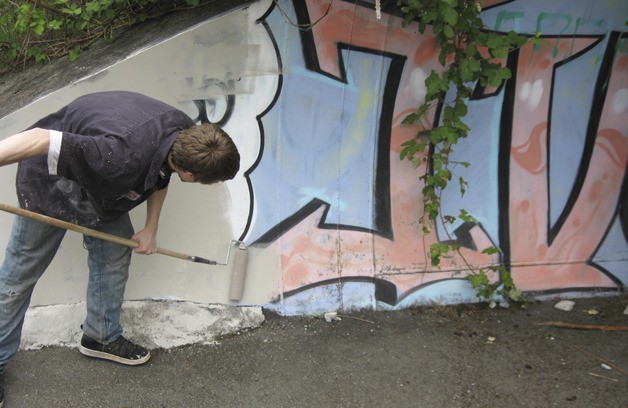For graffiti artists, the writing is on the wall.
Responding to a widespread community problem, the Auburn Police Department and City officials are putting graffiti “taggers” back to work – not with a defacing can of spray paint, but with a paint roller.
Two teenagers whom undercover officers caught in the act a couple of months ago were busy Monday morning applying a fresh coat of gray paint to a graffiti-marred tunnel off East Valley Highway, just north of the Lake Tapps Parkway overpass.
Patrol officers Steve Bourdage and Mike Ashbaugh, part of the police’s community response team, kept a close eye on them. The young “tag” tandem didn’t think much of the restitution.
“Lot of work,” one boy said on break between strokes. “It’s taken me a lot longer to go over it than to put it on.”
Said the other boy: “I’m not going to do this again. This is too much work for some wall that’s only going to be tagged again.”
Perhaps. Consider it community service and a lesson learned.
When it comes to scarring public property, the city is exploring ways to discourage it.
Tagging is easy to do, even more difficult to undo. And Auburn isn’t immune to the aggravation.
“It’s like finding a needle in a haystack,” Bourdage said of chasing down culprits.
Gangs move quickly, hastily marking territory or overstriking another gang’s graffiti in an advertised war on turf. Taggers, on the other hand, consider graffiti a form of expression, a means to recognition and status. Taggers, police say, are inclined to take more time creating public art, and are thus more likely to get caught.
Such was the case when Officers Bourdage and Ashbaugh apprehended the two boys, who were smoking marijuana and redecorating the Highway 18 underpass along the Interurban Trail, one of the city’s magnets for gang graffiti.
“They were dressed in black. They snuck up on us. I thought they were robbers,” said one of the boys.
Each was subsequently charged with a misdemeanor and fined $1,500. To avoid jail and that hefty fine, the taggers found restitution by way of community service, at $9 an hour.
On Monday, the two boys were the first taggers to do so under Auburn’s Community Service Work Program. Established in 2005, the program allows offenders the chance to perform community service, whether it be picking up litter, filling sandbags for flood prep, or, in this case, removing graffiti.
The program addresses graffiti problems affiliated with public, not private, property.
Such a step is important since it is a “visible” response to the victim’s of graffiti. Not all graffiti abatement programs work. Some are burdensome on property owners, others too costly or too slow to be effective.
But Auburn, with all its challenges, is applying its own twist.
“This is a new thing. Hopefully, this is starting a new trend,” Bourdage said. “Instead of incarceration, it’s an opportunity for them to clean up their own mistakes.”
If the program does nothing else, it puts welcomed paint over unwanted paint.
“It shows taggers that if you’re caught, you’re not going to get away with it,” said John Fletcher, who works in employee relations and compensation for the City of Auburn. “You’re going to put some time into it.”
Tagging is only part of a bigger problem as parts of Auburn, notably on the south end and along Lea Hill, confront persistent gang activity. Graffiti, whether gang stained or tagged, continues to scar businesses and frustrate homeowners. It leads to vandalism and other crimes.
You can help
To tackle it, police are asking for the public’s help. They encourage residents to report graffiti immediately, so it can be removed. Moving quickly is key, police say.
Just taking a photo of the graffiti may provide information that will lead to identification of the culprit. Analyzing graffiti can provide valuable information to law enforcement and prosecutors searching to determine patterns or particular geographic areas of graffiti.
According to Bourdage, significant arrests have cut into the gang problem. But that doesn’t necessarily mean graffiti will go away completely.
“We’ve had a lull in it,” Bourdage said, “but yes, it’s a nuisance.”



